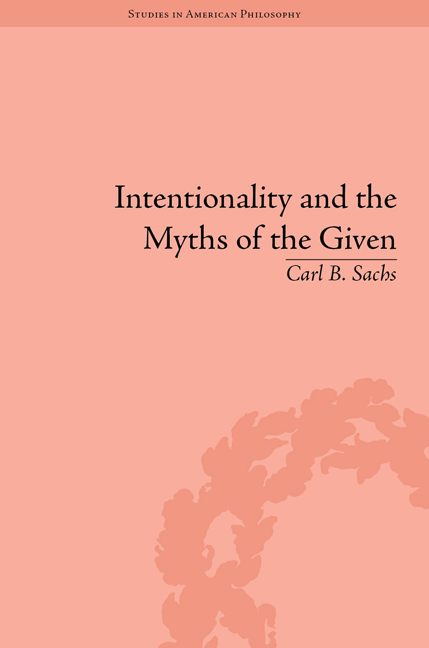Book contents
- Frontmatter
- Contents
- Acknowledgements
- Introduction: Why a New Account of Intentionality?
- 1 Intentionality and the Problem of Transcendental Friction
- 2 The Epistemic Given and the Semantic Given in C. I. Lewis
- 3 Discursive Intentionality and ‘Nonconceptual Content’ in Sellars
- 4 The Retreat from Nonconceptualism: Discourse and Experience in Brandom and McDowell
- 5 Somatic Intentionality and Habitual Normativity in Merleau-Ponty's Account of Lived Embodiment
- 6 The Possibilities and Problems of Bifurcated Intentionality
- Conclusion
- Appendix: Is Phenomenology Committed to the Myth of the Given?
- Works Cited
- Notes
- Index
Introduction: Why a New Account of Intentionality?
- Frontmatter
- Contents
- Acknowledgements
- Introduction: Why a New Account of Intentionality?
- 1 Intentionality and the Problem of Transcendental Friction
- 2 The Epistemic Given and the Semantic Given in C. I. Lewis
- 3 Discursive Intentionality and ‘Nonconceptual Content’ in Sellars
- 4 The Retreat from Nonconceptualism: Discourse and Experience in Brandom and McDowell
- 5 Somatic Intentionality and Habitual Normativity in Merleau-Ponty's Account of Lived Embodiment
- 6 The Possibilities and Problems of Bifurcated Intentionality
- Conclusion
- Appendix: Is Phenomenology Committed to the Myth of the Given?
- Works Cited
- Notes
- Index
Summary
Looking back on what is now canonized as ‘twentieth-century philosophy’, it is tempting to think that ‘the problematic of intentionality’ is a persistent preoccupation, often implicit even where it is not made explicit. Many of the most prominent philosophers on both sides of the Atlantic devoted themselves to such questions as, what is the ‘aboutness’ of thought and perception? How can anything material or physical exhibit intentional states? Can intentional states be modeled or duplicated on a machine? What about animals and babies? The problem of intentionality made its appearance for the twentieth century with Franz Brentano, was refined and reformulated by major figures of both ‘analytic’ (Ryle, Chisholm, Sellars, Brandom, Dennett) and ‘Continental’ persuasions (Husserl, Heidegger, Merleau-Ponty), and has continued today as a central focus of discussion about ‘naturalism’ and its limits. While a few prominent philosophers (such as Richard Rorty) have denied that intentionality marks out anything ontologically, epistemologically, or methodologically distinctive, it is fair to say that most philosophers have been unable to fully dispense with the suspicion, or ‘intuition’, that there has got to be something to the notion of intentionality.
While I share this intuition, I would not seek to ground any argument as to the limits of ‘naturalism’ in an account of intentionality ; on the contrary, I have no reason to deny that ‘intentionality’ cannot be fully ‘naturalized’ – provided a satisfactory account of intentionality and of naturalism.
- Type
- Chapter
- Information
- Intentionality and Myths of the GivenBetween Pragmatism and Phenomenology, pp. 1 - 6Publisher: Pickering & ChattoFirst published in: 2014



